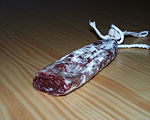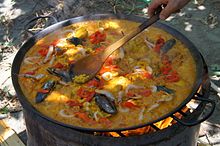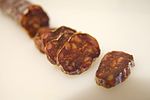Spanish Kitchen
The Spanish cuisine consists of a large variety of regional dishes and specialties. Fish and seafood play an important role, as do legumes in stews. Potatoes are primarily seen as a vegetable; The function of the filling side dish common in German-speaking countries is fulfilled by the ubiquitous white bread at the table. Due to the eventful history of Spain , the cuisine was influenced by different cultures, especially the Moors and Sephardim , enriched after the discovery of America by the importation of agricultural products (tomatoes, potatoes, peppers, cocoa beans) unknown into medieval Europe and today contains a wealth of different ingredients, Preparation methods and typical dishes:
- rich stews with legumes
- Vegetables as an independent course
- a lot of meat, a lot of fish and seafood , pan-fried food served only with a small garnish on the edge of the plate
- Sofrito as a basis for stews and sauces in braised and fish dishes, but also for paella
- Almost exclusive use of olive oil , in the interior of the country with meat dishes occasionally also lard or omitted bacon
- Ingredients usually remain recognizable in the finished meal (no or hardly any pureed or minced dishes)
- sparing use of spices and herbs , with the exception of garlic, which is abundantly used in many dishes
Sauces are rarely served, salads are often made by the guest in the restaurant, olive oil, vinegar and salt are brought by the waiter or are already on the table.
Meals
In contrast to the main meals, the Spanish breakfast, the desayuno , is quite sparse. It usually consists of a coffee and a piece of pastry or a few biscuits, in Andalusia also of a toast flavored with a few spritzes of olive oil, which may also have been rubbed with a clove of garlic beforehand. Breakfast with churros or porras ("Knüppel", the thicker version of the churros) with a cup of hot chocolate is very popular, especially on public holidays or on vacation . It's not uncommon to have breakfast briefly in a café before work.
Lunch is called comida or (rarely) almuerzo , dinner is called cena . Lunch and dinner are generally warm meals. In restaurants, these usually consist of two courses plus dessert, the postre . White bread is often served with meals ; common food drinks are still water, wine and beer. For an aperitif , tapas are often placed on the table, which can be limited to small items such as olives , salted almonds , chorizo , queso manchego and ham . The first course often consists of vegetables, stews, soups or salads , the second course usually consists of meat or fish dishes, but the boundaries are fluid. Usually the first gear is a little easier than the second. For dessert, fruit or desserts, and occasionally yoghurt, are served.
In Spain people eat later than in Germany. Lunch starts between 1.30 p.m. and 3.30 p.m. and dinner between 9 p.m. and 10.30 p.m. The discrepancy is partly caused by the fact that Spain uses the same time zone as Germany but is much further west, i.e. H. Calculated according to pure solar time (with regard to the position of the sun) the difference in meal times between Spain and Germany is much smaller. The warmer climate also has an impact on meal times.
Eating places or bars with lunch or daily menu ("Menú del Día") are well frequented at lunchtime. Outside of normal meal times, there is a habit in Spain of having a bite to eat with a drink in bars, tapas or pinchos . There is the morning coffee break between 9:30 am and 11:30 am and the afternoon break merienda between 5:00 pm and 7:00 pm.
Typical Spanish dishes
Although there are some popular dishes, it is difficult to speak of typical Spanish cuisine. Rather, there are many regional kitchens in Spain , which can be attributed to the diversity of the landscape and climatology.
Potajes, pucheros (stews)
The stew as classic home cooking is often served as a plato único (single course).
- Puchera montañesa, a Cantabrian stew of white beans and kale with pork ribs , bacon , chorizo , morcilla
- Fabada , a bean stew from Asturias
- Lentejas, lentil stew
- Potaje de vigilia, stockfish stew with chickpeas and spinach , made from a sofrito , a classic Good Friday meal
- Marmitako , tuna stew with potatoes , onions , peppers and tomatoes
- Menudo (also: callos a la andaluza ), Andalusian tripe with chickpeas , who with dyed by paprika lard is prepared ( "manteca Colorá")
- Cocido de Garbanzos, chickpea stew
The cocido madrileño , which is served in three courses ("vuelcos"), occupies a special position among the stews : The first course is the cocido broth with pasta boiled in it. The second course consists of the chickpeas and the vegetables, the third course is the meat.
Primer Plato (starter)
- Piriñaca (also called pipirrana or picadillo ), a southern Spanish salad made from chopped onions , tomatoes , sweet peppers and cucumber with olive oil and lots of vinegar , which can be enriched with hard-boiled egg or mackerel fillets
- Fish in escabeche , pickled fish ( tuna , trout , mackerel , and occasionally clams ), served cold or warm
- Sopa de ajo, soup made from garlic and broth, browned in olive oil with spiced paprika, soaked bread and an egg poached in it, from Castile and León
- Sopa de picadillo, chicken broth with a light rice filling, served on finely diced Serrano ham and minced, hard-boiled egg (from the province of Seville )
- Polbo á feira ( Castilian : pulpo a la gallega), boiled octopus dressed with salt, spiced peppers and olive oil, a classic of Galician cuisine
- Ortiguillas, lightly floured sea anemones fried in olive oil , a dish from Cadiz
- Perretxiko nahaskia ( Castilian : revuelto de setas) basque scrambled eggs with Mairitterling
- Espinacas a la catalana, spinach the Catalan way: sautéed with garlic , pine nuts and raisins in olive oil
- Menestra riojana, separately cooked vegetables ( artichokes , green beans , Swiss chard , cauliflower , asparagus , peas , carrots ) are served hot in a clay bowl with a dash of olive oil and decorated with a hard-boiled egg (dish from La Rioja )
- Gambas al ajillo , marinated prawns in a clay bowl
- Angulas a la bilbaína, “ Bilbao-style ” glass eels , fried with garlic and chili peppers in a clay bowl
- Raya en pimentón, liver and fins of a ray in a sauce thickened with breadcrumbs, seasoned with garlic , paprika and cumin , dish from Huelva
- Papas arrugadas , small jacket potatoes with a light salt crust, served with mojo
- Habas con jamón, broad beans with serrano ham (dish from the province of Granada )
- Fideuà , pasta dish with seafood , of Valencian cuisine, with aioli served
- Fritada , stewed vegetables from Aragon
- Gazpacho from Andalusia
- Caracoles a la palentina, pre-cooked snails , cooked on a Sofrito with pork loin , chorizo , Serrano ham , white wine, hard-boiled egg yolk and pine nuts, a preparation from Palencia
- Salmorejo from Córdoba , similar to gazpacho, with Serrano ham and hard-boiled egg
- Ajoblanco , cold soup made from ground, stale white bread , almonds and garlic , olive oil , salt and a dash of vinegar
- Paella , the “ national dish ” of the province of Valencia
- Pisto manchego , stewed vegetables from La Mancha
- Almejas a la marinera , mussels in white wine stock with olive oil, onions and garlic
- Tortilla, especially tortilla española , potato omelette
Segundo Plato (main course)
- Filete de ternera, a large, thinly sliced beef schnitzel
- Carne Guisada , a stew with pieces of meat, potatoes and other vegetables ( peas , carrots ), similar to goulash
- Merluza ( hake ) a la romana (breaded), a la gallega (cooked, garnished with garlic and paprika browned in olive oil), en salsa verde (in green sauce)
- Cazón en adobo (also called bienmesabe ), dog shark marinated in adobo and then floured , a typical dish from the province of Cádiz
- Albóndigas, meatballs in tomato or almond sauce with parsley, fishballs in lime sauce thickened with egg yolk (all sauces are made on a Sofrito )
- Trucha a la navarra, fried trout stuffed with Serrano ham (from Navarre )
- Pollo / conejo / cordero en pepitoria, chicken / rabbit / lamb in an almond-saffron sauce bound with hard egg yolk
- Cordero en chilindrón, lamb in a sauce of onions, tomatoes and peppers (dish from Aragon , Navarra and La Rioja )
- Cordero a la pastora, grilled lamb coated with a spice marinade made from olive oil, garlic, pepper, thyme and white wine , preparation from Teruel
- Cochifrito, lamb or goat meat marinated in wine, fried with garlic , parsley , bay leaf and mint in olive oil and rounded off with vinegar, a dish from Castile-La Mancha
- Perdiz al modo de Alcántara, partridge stuffed with a farce of duck liver , truffles and oloroso , preparation from Extremadura , which was made famous in France by General Junot's wife after the Napoleonic campaign in Portugal in 1807
- Lacón con grelos , pork knuckle with cabbage from Galicia
- Conejo en salmorejo, rabbit in salmorejo canario (a marinade made from salt, garlic, sweet peppers, paprika powder, olive oil and a dash of vinegar), a dish from the Canary Islands
- Pincho moruno from Salamanca
- Riñones al Jerez , kidneys in sherry sauce
- Bacalao ( stockfish ) a la vizcaina (in a sauce made from onions, tomatoes, paprika and garlic), al pil pil (cooked very slowly with garlic in olive oil, whereby the escaping gelatine binds the oil), al ajoarriero (in a sofrito made from olive oil , Sweet peppers, garlic, tomatoes and mashed potatoes cooked)
- Zarzuela , Catalan game fish pan with seafood
Postre (dessert and desserts)
- Almendrados
- Arroz con leche, rice pudding
- Crema Catalana
- Flan
- Natillas
- Turron
- Tortas de aceite
- See also: Cabello de angel
Sauces
- Aioli , ajoaceite ( all i oli , Catalan for garlic and oil )
- Mojo, red or green spicy sauce from the Canarian cuisine
- Mayonnaise , originally mahonesa after Mahón in Menorca
- Salsa vizcaína, a slightly thickened sauce made from fried onion and pepper cubes and fish stock , named after the province of Vizcaya
- Romesco, a Catalan seasoning sauce made from tomatoes, garlic, bread crumbs, dried red sweet peppers, almonds, hazelnuts, rosemary, olive oil, salt and pepper, which is served with pan-fried dishes, fish and vegetables
- Vinagreta, an oil and vinegar mixture
Sausage and ham

Sausage products are called embutidos , and long-life sausage products traditionally dominate in Spain due to the climate. This includes:
- Cecina , air-dried beef
- Chistorra , paprika sausage from Navarre
- Chorizo , paprika sausage
- Fuet , hard sausage from Catalonia
- Lomo embuchado , pork tenderloin marinated with paprika in pork intestines, air-dried
- Longaniza , hard sausage
- Morcilla , black pudding
- Salchichón , hard sausage
- Jamón serrano , air-dried ham
- Jamón Ibérico
Regional kitchens
Typical regional cuisines in Spain are:
- Andalusian cuisine
- Basque cuisine
- Galician cuisine
- Canarian cuisine
- Castilian cuisine
- Catalan cuisine
- Majorcan cuisine
- Valencian cuisine
Internationally known specialties
- Red wine from Rioja
- Jamón Serrano
- Iberian ham
- Cava from the Penedès
- Turron
- Paella from Valencia
- Andalusian gazpacho
- tapas
- Horchata from Valencia
- Tortas de Aceite from Seville
- Manchego cheese from la Mancha
literature
- Culinaria España - Spanish specialties . Könemann Verlagsges. mbH, Cologne 1998, ISBN 3-8290-1442-2
Individual evidence
- ^ Dionisio Pérez, "Guia del buen comer español", Ed. Maxtor 1929, p-40-57




